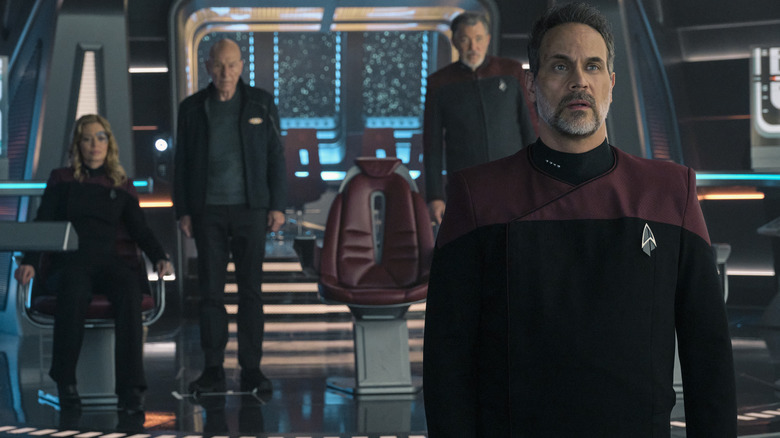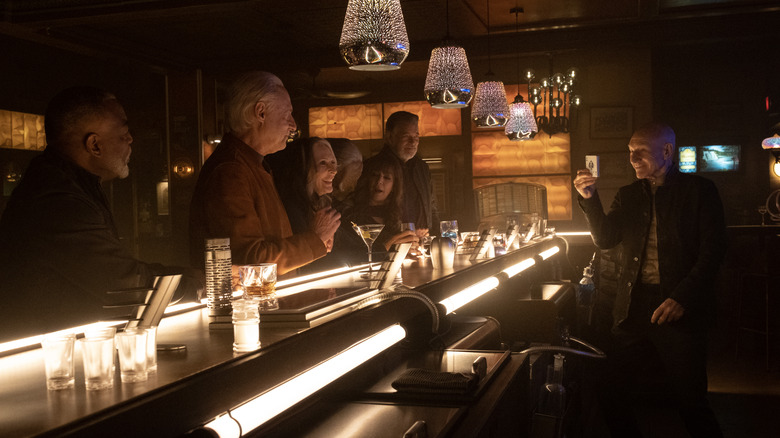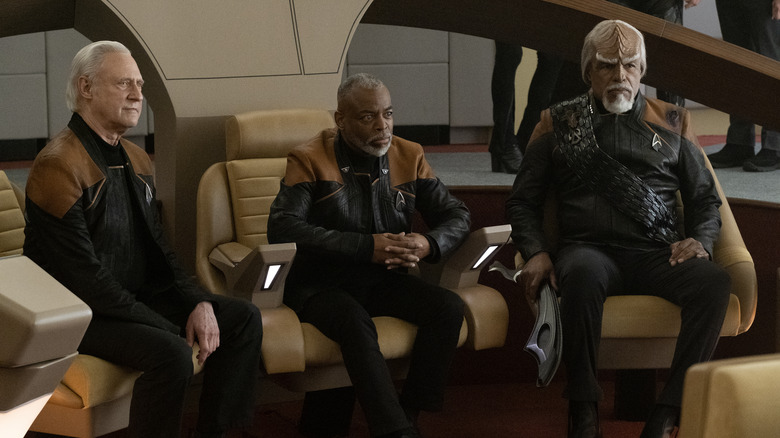How Star Trek: Picard Made The Most Out Of A Smaller Budget For The Sets
To begin with a brief editorial: the unbinding of special effects ultimately harms "Star Trek."
One of the reasons Trekkies become attached to certain characters, or fall in love with the workspaces on various ships and space stations is because the shows spend so much time with them. There are many, many episodes of "Star Trek" that take place entirely on board the Enterprise, and fans — long paying attention — begin to know its geography. After enough time watching a Starfleet vessel, viewers feel like they could, if they should be magically transported there, find their way around.
Taking "Star Trek" away from a starship for too long can, quite tragically, rob a show of a vital sense of place. We, as Trekkies, need to see what everyday life is like on a starship and see what a "normal boring" day looks like before we can appreciate the depth of a crisis. Shows like "Star Trek: Discovery" and "Star Trek: Picard" spent too much time away from centralized starship-bound locations, and the shows lacked cohesion as a result.
That is until the third season of "Picard," which took place mostly on board a ship called the U.S.S. Titan-A, commanded by Captain Liam Shaw (Todd Stashwick). Finally, there was a home base for a new "Star Trek" show.
Naturally, the small number of sets was a budgetary issue, and the showrunners had to get creative with the spaces they had. The third season of "Picard," however, was "the good one," proving that "Star Trek" is better when it has to work with smaller amounts of money. Production designer David Blass talked about the limitations in a 2023 interview with ComingSoon.net, and he confessed that he was able to work well with limited space.
How little can you get away with?
The locations on "Picard" are plentiful, but the most heavily visited places can be remembered easily. A lot of time was spent on the bridge of the Titan, and a lot of time was spent in Guinan's bar. The showrunners also had the characters on the Titan recreate Guinan's bar on the ship's holodeck, so the set was used even when the action took place far from Earth. There was a sickbay which was also clearly used as other scientific labs in other scenes. The most attention was paid to recreating the set of the Enterprise-D bridge, as that ship was rebuilt decades after it had been destroyed. A lot of the final two episodes of the show took place on the Enterprise-D bridge.
Blass recalls the experience of having to pare down his ideas, and then pare them down again, knowing that he only had a limited budget. At the end of the day, though, Blass found out ways to make it work, and work well. The compromise was hard, but doable. He said:
"Season three was just such a massive challenge because every script would come and it was huge. Then it was the emotional compromise of, 'Here, I want to design this new set and make it cool. I want to do this.' Then you submit it — this big huge set — and they're like, 'Okay, that's $5 million.' And I'm like, 'How much do we have?' And they're like, '500.' And you're like, 'Oh, okay, maybe the set's this big, then.' So it was just a weekly compromise of, 'Here's what I want to do, here's what we get to do.' In the end, it's actually fine."
Necessity is the mother of invention.
Great use of the space
With fewer sets, Blass learned how to redress areas and reused sets pretty quickly. One might argue that using redressed sets might even give actors a greater sense of ease, allowing them to give better performances while occupying a familiar space. After a while, Blass even began to feel proud of his innovations, explaining the way he would film two very different scenes using two halves of the same room. TV magic, baby. Blass said:
"I think my best example of this is the fact that we only had one bedroom, or one quarters, for everyone. Everyone has the same teeny tiny room and we redressed it, but there's a scene that Terry shot in the finale where we go from Raffi and Worf having a scene in the room, and then without any cut to anything else, we go to Data and Troy in the same exact room having a scene together, and it completely works."
Worf (Michael Dorn) and Raffi (Michelle Hurd) had a farewell conversation at the end of "Picard," as their time working together was to come to an end. Shortly thereafter Data (Brent Spiner) and Troi (Marina Sirtis) conversed in her "office" about his newfound emotional state. One would never guess that those scenes were in the same room. Blass may have wanted multiple $5 million sets but was seemingly better served by being creative with the space they had.


